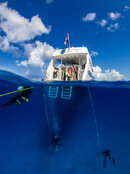Hi all,
I'm about to buy a sony a6300 with nauticam housing, mainly for wide angle and fisheye photography (reefscapes, shipwrecks, over-under, etc.). I am torn between the following setups:
Sony 16-50mm + Nauticam's Wet Wide Lens (WWL-1)
Sony 10-18mm + 7" N85 Acrylic dome port
Sony E16mm + fisheye converter + 4.33" N85 acrylic fisheye port
Any advice on the best setup for the widest angles that is also suitable for the subjects I want to shoot? The fisheye setup is of course widest, but I'm worried that the small size of the port (4.33") won't be ideal for over-under shots. Is the fisheye lens option also useable on the 7" dome port?
IBy the way I also looked at the tokina 10-17mm with metabones converter, but I read that focusing with this setup is terrible, so that's not an option.
Thanks for any advice you can provide!
I'm about to buy a sony a6300 with nauticam housing, mainly for wide angle and fisheye photography (reefscapes, shipwrecks, over-under, etc.). I am torn between the following setups:
Sony 16-50mm + Nauticam's Wet Wide Lens (WWL-1)
Sony 10-18mm + 7" N85 Acrylic dome port
Sony E16mm + fisheye converter + 4.33" N85 acrylic fisheye port
Any advice on the best setup for the widest angles that is also suitable for the subjects I want to shoot? The fisheye setup is of course widest, but I'm worried that the small size of the port (4.33") won't be ideal for over-under shots. Is the fisheye lens option also useable on the 7" dome port?
IBy the way I also looked at the tokina 10-17mm with metabones converter, but I read that focusing with this setup is terrible, so that's not an option.
Thanks for any advice you can provide!





